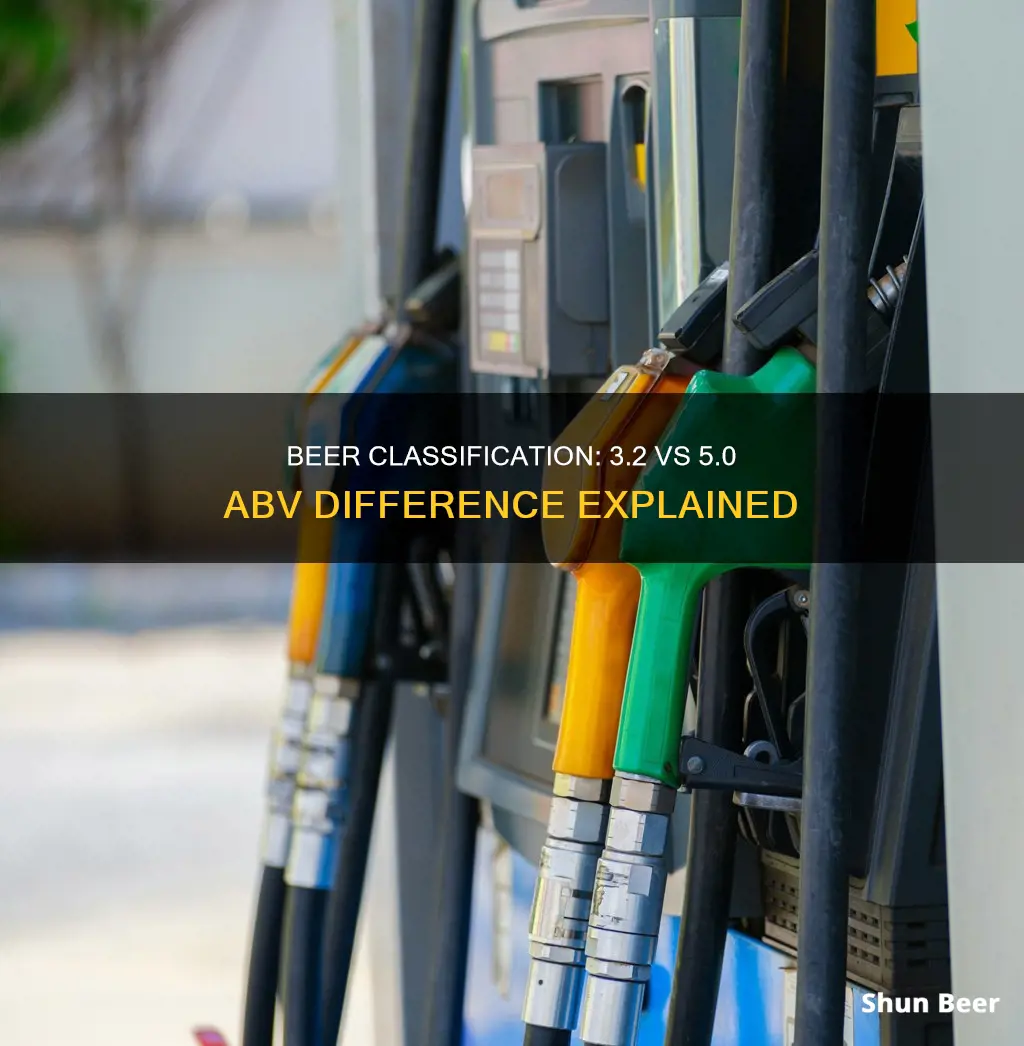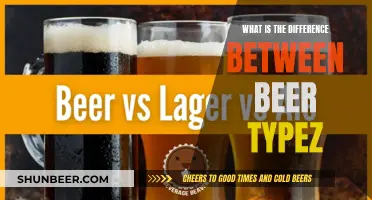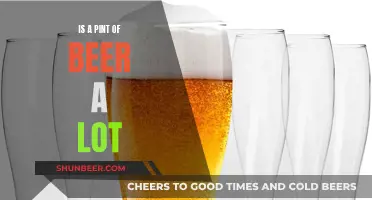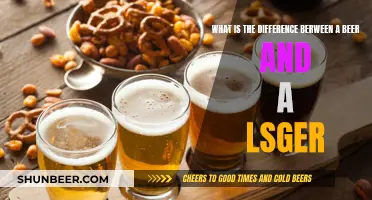
3.2 beer and 5.0 beer differ in alcohol content, with 3.2 beer containing 3.2% alcohol by weight or 4% alcohol by volume, and 5.0 beer containing 5% alcohol by volume. This difference in alcohol content also results in variations in flavour and calorie density between the two types of beer. 3.2 beer is considered a low-alcohol or light beer, and was introduced in the 1930s after Prohibition.
What You'll Learn

History of 3.2% beer
2% beer, also known as "three-two beer" or "3 point 2 brew", is a beer that contains 3.2% alcohol by weight (equivalent to about 4% ABV). The history of 3.2% beer in the United States is closely tied to the Prohibition era and the subsequent regulatory landscape surrounding alcohol.
During Prohibition, which was established by the 18th Amendment and enforced by the Volstead Act, the sale and consumption of alcoholic beverages were outlawed in the United States. However, there was no clear definition of "intoxicating liquors," and efforts were made to change the level of alcohol content deemed intoxicating. These efforts included scientific arguments and even a proposal by President Wilson to limit malt beverage alcohol content to 2.75%. Ultimately, these attempts failed to change the law.
In 1932, Franklin D. Roosevelt ran for president with a promise to modify the Volstead Act and work towards repealing Prohibition. After his election, Roosevelt signed the Beer and Wine Revenue Act in 1933, nine months before Prohibition was fully repealed. As a compromise, the act set the legal alcohol limit for beer at 3.2% alcohol by weight. This limit was arbitrary and not based on any scientific criteria.
The 3.2% beer became known as a "long shadow of Prohibition," as it represented a middle ground between allowing alcohol and maintaining temperance. This type of beer was regulated separately from other alcoholic beverages, and some states made special provisions for it. In some states, 3.2% beer was the only alcoholic drink allowed, while others made it more accessible than stronger beers, wines, and spirits.
Sales of 3.2% beer were particularly high in the 1970s, partly due to teen consumption. At the time, many states had different consumption rules for 18- to 21-year-olds, and 18-year-olds could legally drink 3.2% beer in several states. This contributed to the popularity of this type of beer during that decade.
However, as states began to adopt a uniform minimum drinking age of 21, the special rules for 3.2% beer were gradually eliminated. By the 2010s, states like Colorado, Kansas, Oklahoma, and Utah had revised their laws to end the practice of limiting beer sales to 3.2% alcohol by weight. As of 2019, Minnesota was one of the last states to permit the sale of 3.2% beer in general establishments, but even there, the market for this type of beer was drying up.
Explore the World of Beer: Case Options and More!
You may want to see also

Alcohol content
2 beer, also known as light beer, low-alcohol beer, or low-point beer, contains 3.2% alcohol by weight or 4% alcohol by volume. This is in contrast to regular beer, which typically has an alcohol content of 5% ABV or higher. The term "3.2 beer" originated in the United States during the Prohibition era when people sought to produce and consume alcoholic beverages with a lower alcohol content to avoid detection by authorities.
The history of 3.2 beer dates back to the 1930s, when it was created as a compromise during the transition from Prohibition to the legalisation of alcohol. In 1933, President Franklin D. Roosevelt signed the Beer and Wine Revenue Act, allowing beer with an alcohol content of 3.2%. This percentage was considered a non-intoxicating standard, as it allowed individuals to drink and still walk in a straight line.
The popularity of 3.2 beer has fluctuated over the years, with sales peaking in the 1970s due to teen consumption. At that time, many states had a minimum drinking age of 18, and 3.2 beer was the only option available to this younger demographic. However, as states gradually increased the drinking age to 21, the demand for 3.2 beer decreased.
In recent years, there has been a shift away from 3.2 beer towards full-strength craft beers. As of 2019, only a handful of states still have 3.2 beer regulations, with Minnesota being the only state restricting convenience and grocery stores to selling beer with an alcohol content of 3.2%. The decline in the popularity of 3.2 beer can be attributed to consumer preferences for beers with higher alcohol content and the expansion of craft beer options.
What Makes Bock Beer Unique and Different?
You may want to see also

Calories
When it comes to calories, there are a few things to consider when comparing 3.2% and 5% beers. Firstly, it's important to understand that the calorie content in beer depends on various factors such as alcohol levels, sugar content, and carbohydrate content. Additionally, the brewing process and ingredients used can also play a role in the final calorie count.
In general, a higher alcohol content will result in a higher calorie count. This is because alcohol has a higher number of calories per gram (7) compared to carbohydrates (4). Therefore, a 5% ABV beer will typically contain more calories than a 3.2% ABV beer. However, other factors such as sugar and carbohydrate content can also significantly impact the overall calorie count.
To calculate the approximate number of calories in a beer, you can use the formula: Approx. Calories = (ABV% * 2.5) * volume in ounces. For example, a 5% ABV beer with a volume of 12 ounces would have approximately 150 calories [(5% * 2.5) * 12 = 150]. On the other hand, a 3.2% ABV beer with the same volume would have approximately 120 calories [(3.2% * 2.5) * 12 = 120].
It's worth noting that the type of beer, such as lager or IPA, can also affect the calorie count. For instance, IPAs tend to have a higher calorie range due to their high hop content. Additionally, the term ""light" on a beer label can be confusing. In the UK, "light" typically refers to a reduced level of alcohol, which may result in a lower number of calories. However, this is relative to the brand's regular beer, and a "light" beer may still have more calories than a regular beer from another brand.
Non-alcoholic and low-alcohol beers are worth considering if you're watching your calorie intake. These beers typically have significantly fewer calories than their full-strength counterparts. For example, a 5% ABV lager may have around 150 calories per 330ml, while a non-alcoholic beer may have around 70 calories per can. However, it's important to note that alcohol-free and low-alcohol beers still contain some alcohol, usually up to 0.5% ABV for alcohol-free and 1.2% ABV for low-alcohol.
In conclusion, when comparing 3.2% and 5% beers, the 5% beer will likely have a higher calorie count due to the higher alcohol content. However, other factors such as sugar and carbohydrate content, as well as the specific type of beer, can also impact the overall calorie count. Choosing non-alcoholic or low-alcohol options can be a good way to reduce calorie intake, but it's always a good idea to check the label for accurate nutritional information.
Stroh's Beer: Unique Characteristics and Distinctions
You may want to see also

Availability
The availability of 3.2% and 5.0% beers varies across the world. In the United States, 3.2% beer was the highest alcohol content beer that could be legally produced for nine months in 1933. This was due to Prohibition-era laws that limited alcohol content. While Prohibition was repealed in 1933, some states continued to restrict the sale of intoxicating liquors, setting the maximum alcohol content for beer at 3.2% alcohol by weight (ABW). As of 2019, Minnesota was the only state that limited the sale of beer in general establishments such as supermarkets and convenience stores to 3.2% ABW. However, even in Minnesota, grocery stores are not required to sell only low-point beer, and 3.2% beer is rarely purchased. In recent years, states such as Colorado, Kansas, Oklahoma, and Utah have changed their laws to allow the sale of beer with alcohol content higher than 3.2%.
In Canada, regular beers typically contain 5% ABV, while reduced-alcohol beers have an alcohol content between 2.6% and 4.0% ABV. "Extra-light" beers in Canada contain less than 2.5% ABV. In Australia, regular beers have approximately 4% to 5% ABV, while reduced-alcohol beers range from 2.2% to 3.2% ABV. "Light beer" in Australia refers to any beer with less than 3.5% ABV.
In Sweden, low-alcohol beer is available at 2.2%, 2.8%, or 3.5% ABV in ordinary supermarkets, while beers above 3.5% ABV must be purchased at government-run liquor stores. Beer with 3.5% ABV or lower can be sold to individuals over 18 years old, while stronger beers can only be sold to those over 20. In the United Kingdom, beers with 2.8% ABV or less are subject to a lower rate of beer duty, encouraging brewers to create craft beers at lower alcohol levels. In the United States, most mass-market light beer brands, including Bud Light, Coors Light, and Miller Lite, have 4.2% ABV, while their ordinary beers have 5% ABV.
The global market for non-alcoholic and low-alcohol beers has been growing, driven by factors such as health consciousness, social preferences, and the desire to enjoy the taste of beer without the effects of alcohol. This trend is particularly prominent in the Middle East, which accounts for a significant portion of worldwide sales of non-alcoholic and alcohol-free beers. In the United States, there has been a rise in the consumption of non-alcoholic beers over the last decade.
Stout vs Beer: What's the Difference?
You may want to see also

Taste
The main difference between 3.2% and 5.0% beers is their alcohol content, which affects their taste and likelihood of intoxication.
The taste of beer varies depending on its alcohol content. Beers with lower alcohol content tend to be lighter and have a less intense flavour, while beers with higher alcohol content have a stronger and more acquired taste.
The alcohol content of a beer is measured by percentage of alcohol by volume (ABV). A beer with 3.2% alcohol by weight (ABW) is equivalent to approximately 4.0% ABV, while a beer with 5.0% ABV is considered a "regular" beer in terms of alcohol content.
Beers with an ABV of less than 5% are considered "light" or "low-point" beers, and are often chosen for light drinking occasions, such as during lunch or when one needs to return to work still feeling sober. They are also a good option for those who want to reduce their alcohol consumption without giving up beer entirely.
On the other hand, beers with an ABV of 5% or higher are considered regular beers and will have a more pronounced flavour. These beers are more likely to have food pairings and are typically consumed in smaller quantities due to their higher alcohol content.
The difference in alcohol content between 3.2% and 5.0% beers may not seem significant, but it does affect the overall taste and drinking experience. With a 3.2% beer, one might need to drink more bottles to feel the same effects as a 5.0% beer.
Additionally, the calorie count of a beer is closely related to its alcohol content. Regular beers with 5.0% ABV tend to have more calories than low-point beers with 3.2% ABW or 4.0% ABV. This is another factor to consider when choosing between these two types of beers, especially for those conscious of their calorie intake or watching their weight.
In summary, the taste of 3.2% and 5.0% beers differs due to their varying alcohol content, with the former being lighter and less intoxicating, and the latter having a stronger flavour and effect. The choice between the two ultimately depends on personal preferences, the occasion, and the desired level of intoxication.
Beer vs Spirits: Understanding Alcoholic Beverage Differences
You may want to see also
Frequently asked questions
3.2 beer is a term used to refer to low-alcohol content beer that has an alcohol content of 3.2% by weight or 4% by volume. It is also known as light beer, low-point beer, or non-alcoholic beer.
5.0 beer is regular beer, which typically has an alcohol content of 5% alcohol by volume.
The main difference between 3.2 beer and 5.0 beer is their alcohol content. 3.2 beer has a lower alcohol content than regular 5.0 beer, making it a healthier choice for those watching their weight or wanting to avoid intoxication.







